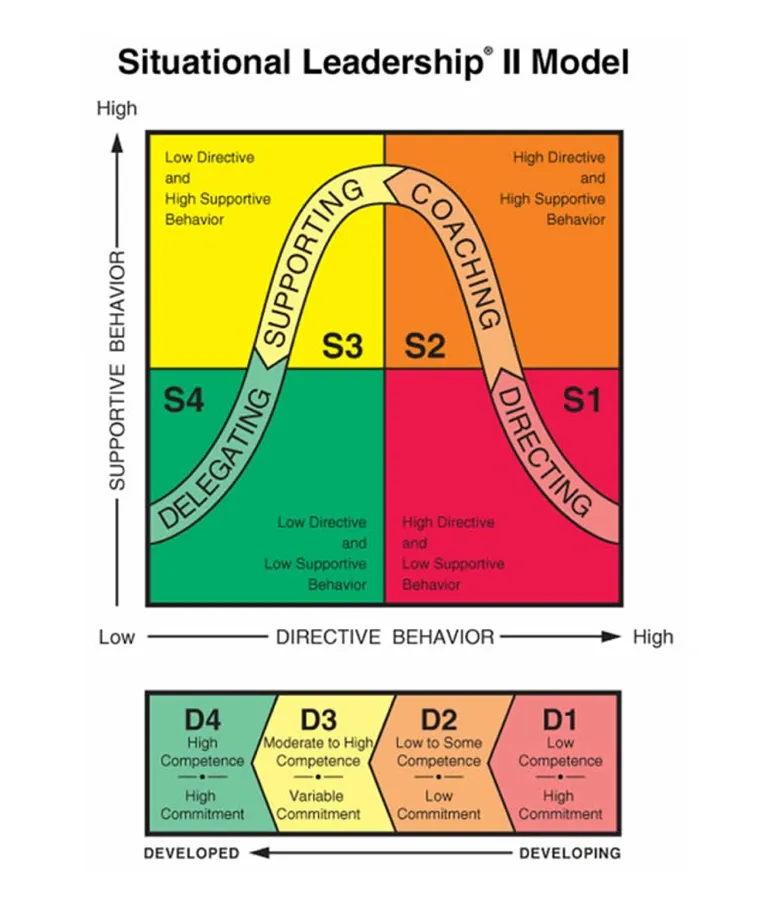One framework that I picked up and stuck with me is the Situational Leadership. It is an adaptation framework to adjust leadership style to effectively manage a team. Overtime I adopted a slightly different version of the framework, and have been using it as a communication framework to have performance conversations.
The original framework is based on the competence and commitment of team members. It can be described in the following 2x2.

The original situational leadership matrix classifies followers into four categories based on their ability (task-specific skills) and willingness (confidence, motivation, or commitment). Each quadrant prescribes a distinct leadership approach:
| Leadership Style | Follower Readiness | Leader Behavior | Example |
|---|---|---|---|
| S1: Telling/Directing | Low ability, Low willingness | High task, Low relationship: Clear instructions, close supervision, minimal collaboration | A new hire unfamiliar with protocols requires step-by-step guidance |
| S2: Selling/Coaching | Low ability, High willingness | High task, High relationship: Explanations, encouragement, and collaborative problem-solving | A junior employee eager to learn but lacking expertise benefits from mentorship |
| S3: Participating/Supporting | High ability, Low willingness | Low task, High relationship: Delegation of decisions with emotional support | A skilled employee experiencing burnout needs autonomy paired with reassurance |
| S4: Delegating | High ability, High willingness | Low task, Low relationship: Empowerment with minimal oversight | A senior team member leading a project independently |
What I found this framework lacking is the one-way-ness of the framework. It tends to describe how would a manager treat their team member, but ignored the relationships building of the team. What it also lacks is the relationship between the manager and their report.
Relationship building in essential in workplace because for me, the job is a part of life, and we know a major source of happiness in life comes from relationships. Trusting relationship enables direct feedback and reduces thrash, and hence a higher performance team.
The situational leadership I have adapted to replace the willingness component to Trust. Willingness is a part of ability, with the idea that ability includes do whatever it takes to get the job done.
With that, the new 2x2 quardrant looks like this:
- if someone has low trust and low ability, I need to be direct and provide clear instructions on what needs to be done.
- If they have high trust but low ability, I will spend more time teaching and guiding them.
- If they have high ability but low trust, it is time to educate me on their vision and let the result speaks loudest
- When someone has both high ability and high trust, my role shifts to coaching them towards the next level.
Or as the table summarizes it:
| Zone | Trust | Ability | Approach |
|---|---|---|---|
| Directive | Low | Low | Be direct. Provide clear instructions and define what needs to be done. |
| Coaching | High | Low | Spend more time teaching, guiding, and building ability through trust. |
| Reverse Coaching & Show Results | Low | High | Educate me on your thinking. Let your results speak for themselves to build trust. |
| Supporting | High | High | My role is to coach you to the next level. Support and empower your growth. |
This framework is not only visible in my head. I introduce this framework during the first meeting with every new hire, and I constantly bring it up during career / performance conversation, even project reviews. It demonstrates how we are performing together.
Often time when performance slips, I feel more responsible. Either my trust was set too high without evidence, or I didn't spent enough effort coaching or directing effectively.
The combined end goal is to move every situation, every project, from any quardrant to upper right. This enable people to do the best job with my full support.